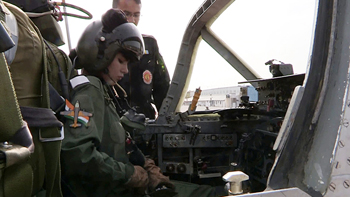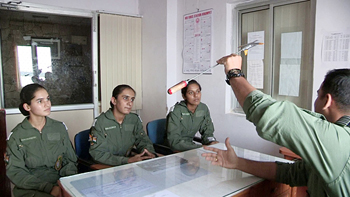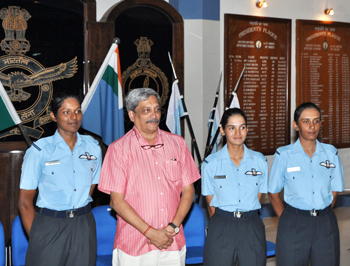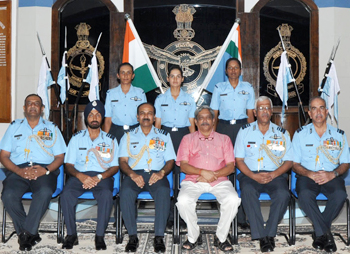INDIAN ARMED FORCES CHIEFS ON OUR RELENTLESS AND FOCUSED PUBLISHING EFFORTS

SP Guide Publications puts forth a well compiled articulation of issues, pursuits and accomplishments of the Indian Army, over the years

"Over the past 60 years, the growth of SP Guide Publications has mirrored the rising stature of Indian Navy. Its well-researched and informative magazines on Defence and Aerospace sector have served to shape an educated opinion of our military personnel, policy makers and the public alike. I wish SP's Publication team continued success, fair winds and following seas in all future endeavour!"

Since, its inception in 1964, SP Guide Publications has consistently demonstrated commitment to high-quality journalism in the aerospace and defence sectors, earning a well-deserved reputation as Asia's largest media house in this domain. I wish SP Guide Publications continued success in its pursuit of excellence.
Women breaking barriers!
The commissioning of female pilots into the fighter stream of the IAF will indeed be inspiring as well as challenging for the future generations of women.
 |
By Air Marshal B.K. Pandey (Retd) Former Air Officer Commanding-in-Chief of Training Command, IAF |




History was scripted for the Indian Air Force (IAF) on Saturday, June 18, 2016, when Manohar Parrikar, the Minister Defence, the Chief Guest and the Reviewing Officer, formally conferred the President's Commission on to three women fighter pilots along with other flight cadets of various branches of the IAF, at a combined graduation parade held at the Air Force Academy in Dundigal, North of Hyderabad. This will indeed be recorded as a landmark event in the glorious history of the IAF and will be seen as the proverbial "feather in the cap" of the service. This day also marked the fulfilment of the commitment by Air Chief Marshal Arup Raha, Chief of the Air Staff made on the last International Women's Day that the nation would see its first batch of female fighter pilots on June 18, 2016. In his address on the occasion of the combined graduation parade, the Minister of Defence assured the audience that step by step, total gender parity will be achieved in the armed forces in the coming years and that the technical or administrative difficulties in this regard if any, would be removed.
Women have been serving in the flying branch of the IAF for over two decades. Currently on the rolls of the IAF are nearly 100 women pilots and 20 women navigators. However, these have been restricted to flying transport aircraft and rotary wing platforms only. They did not have the option to join the fighter stream on account of policy restrictions prevailing at that time. Women pilots and navigators have been operating transport aircraft to forward bases and flying helicopters even in remote and high altitude areas and over inhospitable terrain such as that of the Siachen Glacier. With the same level of training and grooming, they have, in no way, proved to be less capable than their male counterparts.
However, following a radical shift in policy, India's first three women pilots allocated to the fighter stream namely Flying Officer Bhawana Kanth, Flying Officer Avani Chatuvedi and Flying Officer Mohana Singh, have successfully completed Stage II of the training schedule for fighter pilots having logged a total of around 150 hours of flying on the Pilatus PC-7 Mk II basic trainer aircraft procured from Switzerland and on the HAL-built jet trainer, the HJT-36 Kiran. They were also awarded the pilot's "Wings" coveted by all those aspiring for flying career in the IAF. They will now relocate to Air Force Station, Bidar in North Karnataka for Stage III of their training scheduled on the BAE Hawk 132, Advanced Jet Trainer. On successful completion of Stage III, these three women fighter pilots will be assigned to different combat squadrons equipped with supersonic fighter aircraft such as the MiG-21, the Mirage 2000 and the Su-30 MKI. It is in the combat squadrons that they will be required to undergo operational training along with their male colleagues before being declared fully operational or in other words "combat capable" on any of these aircraft. This will by no means be an ordinary achievement for these high flying young girls fired by ambition to perform the combat role in the IAF! This is expected to inspire others to follow in their footsteps and hopefully reverse the declining trend amongst young women in the country to opt for the military as a career.
While entry of women into the fighter stream is indeed a landmark event, for the management in the IAF, there are issues of serious concern.
Women have been flying combat aircraft successfully in a number of countries of the world such as the US, Russia, UK, Canada, France, Germany, Norway, the Netherlands, Turkey, Israel, China, Singapore and even Pakistan that is three years ahead of India in this regard. The first woman in the world to be employed in a flying combat role was Sabiha Gökçen of Turkey in 1936. The US Defence Secretary Ashton Carter had stated a few months ago that the US government had moved even further and decided to open to women all positions including frontline combat roles in the armed forces. Said Defence Secretary Carter "We cannot afford to cut ourselves off from half the country's talents and skills. We have to take full advantage of every individual who can meet the laid down standards." This philosophy ought to apply in the Indian context as well.
The US Air Force inducted its first woman fighter pilot Col Jeannie Leavitt in 1993. About the same time, the US Navy commissioned Lieutenant Kara Spears Hultgreen as the first carrier-borne combat pilot. Unfortunately she died soon after in a crash at sea while flying the F-14 Tomcat. The UK followed suit in 1994 and today in the Royal Air Force, there are ten women fighter pilots flying the Eurofighter Typhoon or Tornado jets in combat missions. RAF women combat pilots flying the Tornado are reported to have flown hundreds of operational missions over Afghanistan as part of Britain's offensive against the Taliban. A female fighter pilot of the RAF led the first aerial combat mission into Iraq operating from an RAF base in Cyprus. It was a highly dangerous mission over territory in Northern Iraq held by the ISIS. In Israel, women pilots had flown combat missions during the Israeli War of Independence; but thereafter women were excluded from combat flying. This restriction was lifted in 1995 following which the first woman to earn wings in 2001 as a fighter pilot was Lt Roni Zuckerman. Closer home, in June 2013, Flight Lieutenant Ayesha Farooq, one of the 19 female pilots in the Pakistan Air Force (PAF), became the first one to be a part of the fighter stream flying the Chinese made F-7PG. Tragically, in November last year, Marium Mukhtiar, another Pakistani female fighter pilot in the PAF succumbed to her injuries sustained during ejection from a combat aircraft following a serious emergency in the air.
A woman going into combat is neither without precedent nor alien to Indian culture or tradition. After all, in 1858, the Rani of Jhansi, went into the battlefield on horseback with sword in hand and her infant son strapped to her back to take on the British who were on the offensive. Tragically, the Rani and her son were both martyred. She had left instructions with her soldiers that in case she dies in battle, her body must be burnt immediately and that under no circumstances should the British soldiers be able to get hold of it.
While entry of women into the fighter stream is indeed a landmark event, for the management in the IAF, there are issues of serious concern. There is genuine apprehension about the fate of a woman fighter pilot if she is shot down over enemy territory and is captured alive. To obviate this possibility, there is a suggestion that women fighter pilots should be employed only in the air defence role or other missions within the boundaries of the nation.
In the final analysis it is really not a contest of skills between male and female fighter pilots. The three young ladies commissioned recently as fighter pilots have been reported to have performed as well and even better than their male colleagues. The latest move to induct them into the fighter stream of the IAF will indeed be inspiring as well as challenging for the future generations of women who aspire to "Touch the Sky with Glory" and a positive development in respect of their emancipation and fulfilment of aspirations!





